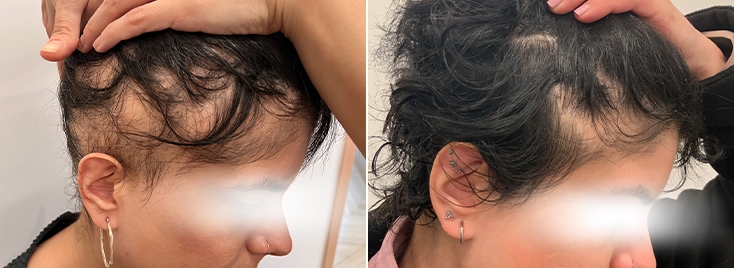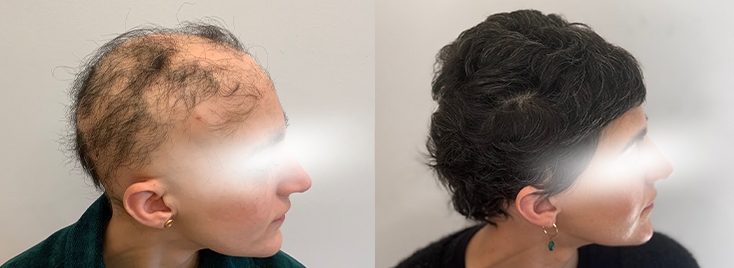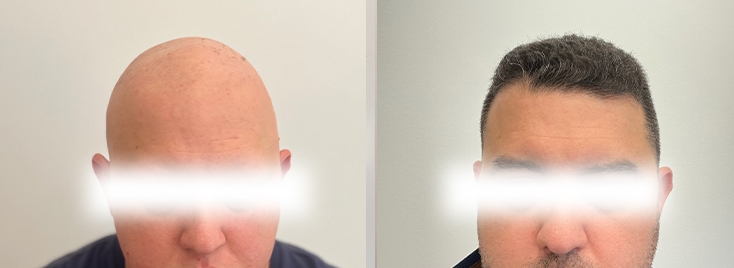Alopecia Areata

Alopecia Areata belongs to the category of hair disorders and is a condition that leads to hair loss due to inflammation that occurs in the hair follicle. It affects only about 2% of the population. It affects both genders equally and is also often observed in children.
It is an autoimmune disease. The main characteristic is small bald patches on the scalp. It’s worth noting that this type of disease can affect any hairy area, including body regions.
Individualized Treatment
Treatment for Hair Loss
Combination Therapy
Before & After Olumiant treatment
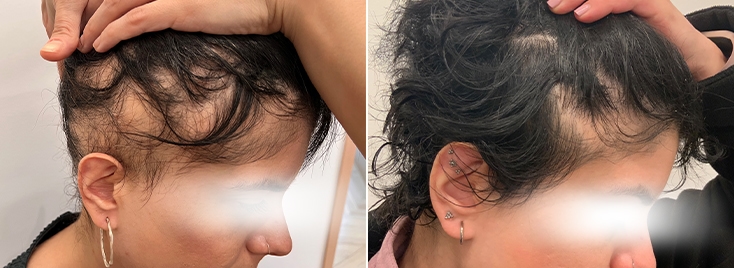
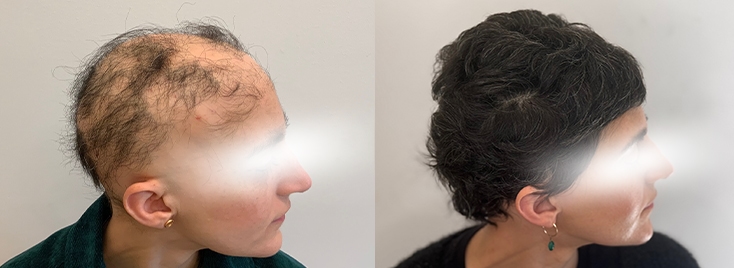
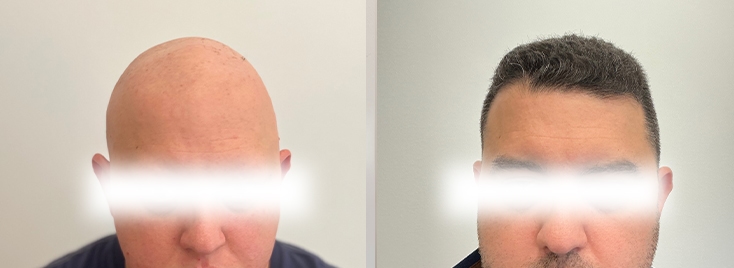
What factors lead to the appearance of alopecia areata?
Some of the factors contributing to the onset of alopecia areata are:

Intense stress

Hormonal imbalances

Genetic predisposition

Inflammation/Infections

Allergic reactions

Minor injuries to the area
What are the symptoms of alopecia areata?

The severity of hair loss varies from person to person and can appear unexpectedly. It can create small round patches of hair loss on the scalp or another part of the body, and in some cases, it can lead to extensive or total hair loss.
It is non-scarring and typically does not come with other symptoms, but it may cause itching, pain, or a burning sensation before the hair falls out.
A key characteristic for diagnosing the condition is the “exclamation point” shape of the hair as well as the presence of black dots.
Clinical disappearance of alopecia areata
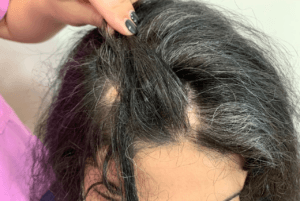
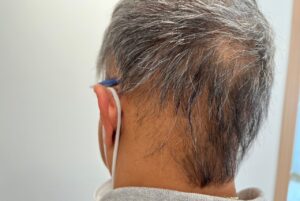
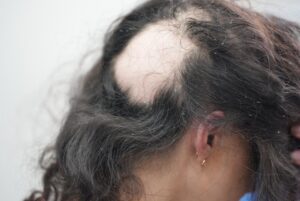
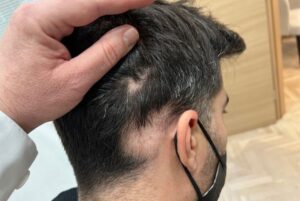
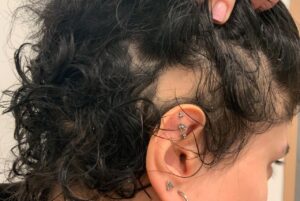
Expression of Interest Form
Error: Contact form not found.
Psychological Effects of Alopecia Areata
This condition, according to studies, has been shown to significantly affect the quality of life of patients as it is associated with increased anxiety and depressive moods. In fact, one study indicated that the impact on the quality of life for patients is similar to that experienced by those with other chronic skin conditions such as atopic dermatitis and psoriasis.
Alopecia areata can also affect the social lives of patients, as those suffering from this condition often feel rejected by their social environment. Additionally, it can impact their mental state, leading to disorders like anxiety episodes, agoraphobia, and even suicidal thoughts.
It’s also noteworthy that depression and anxiety do not correlate with the severity of the disease, meaning that individuals with mild cases of alopecia areata can also experience these psychological effects to a significant degree.
Therefore, patients with alopecia areata, regardless of severity, should seek psychological support from a specialized dermatologist who is monitoring them and from a psychiatrist or psychologist who can offer psychotherapy or medication. In many cases, support should also be extended to other family members of patients with alopecia areata.
Methods to Manage Alopecia Areata
The progression of alopecia areata is unpredictable. In some cases, hair regrowth can occur without treatment within a few months. However, therapeutic intervention is often deemed necessary when the condition has a psychological impact on the patient. The treatment approach depends on the extent and severity of the condition and is tailored to each individual’s needs.
The treatment of alopecia areata can include:
- Corticosteroid therapy (injections or topical application of cortisone)
- Topical application of minoxidil
- Systemic administration of cyclosporine
- Anthralin
- Homeopathic treatment
- Psychological support
- Photodynamic therapy
- Low-Level Laser Therapy (LLLT)
- Autologous mesotherapy with Platelet-Rich Plasma (PRP)
- Fractional Erbium Laser
- Immunotherapy with Diphencyprone (DPCP), starting with a 2% sensitization solution
- Newer treatments for alopecia areata
New Treatments for Alopecia Areata
Olumiant (Baricitinib) is a medication initially approved for rheumatoid arthritis. It recently received approval from the United States Food and Drug Administration (FDA) for treating alopecia areata. Its mechanism of action involves selectively inhibiting Jak kinases, which are enzymes involved in intracellular signal transduction from cell surface receptors.
Thus, the transmission of inflammation is inhibited. Since alopecia areata is an autoimmune condition linked to inflammation, particularly involving T lymphocytes found in clinically affected areas, Olumiant seems to significantly help. The usual dosage is four milligrams daily, and it appears to clinically improve 72.4% of patients to whom it is administered, with improvement observed after 2.2-9 months of continuous administration.
Adverse effects are relatively rare, with the most common being upper respiratory infections causing cold-like symptoms. Despite its benefits, the medication is immunomodulatory and immunosuppressive, requiring careful monitoring by an experienced specialist.
New Treatment
Είπαν για εμάς
EXCELLENTTrustindex verifies that the original source of the review is Google. Τον εμπιστεύομαι χρόνια!! Είναι ένας εξαιρετικός επιστήμονας με πραγματικό ενδιαφέρον και γνώση για τον ασθενή!!Τον συνιστώ ανεπιφύλακτα τόσο για ιατρικά όσο και τις αισθητικές υπηρεσίες που προσφέρει ο χώρος.Trustindex verifies that the original source of the review is Google. Εξαιρετικός ιατρός, άριστα καταρτισμένος! Το ίδιο και όλο το προσωπικό! Πολλά μπράβο για όλη του την ομάδα!!Trustindex verifies that the original source of the review is Google. Εξαιρετικός γιατρός, τον συστήνω ανεπιφύλακτα!!Trustindex verifies that the original source of the review is Google. Excellent serviceTrustindex verifies that the original source of the review is Google. Έκανα αφαίρεση σπιλων με τον γιατρό και έμεινα απόλυτα ικανοποιημένη και από την διαδικασία αλλά και από την μετέπειτα παρακολούθηση μέχρι την αποθεραπεία !!!! Ευχαριστώ πολύ ❤️

HAIR TRANSPLANT;
Book a FREE 20 minute consultation for Hair Transplant!

FAQ
Absolutely not. Alopecia areata is an autoimmune disease that affects approximately 2% of the population.
No! The condition usually manifests suddenly with the appearance of bald patches in various areas of the scalp. However, it can also appear in other parts of the body, such as the beard, eyebrows, or even other hairy areas of the body. In rare cases, all hair can disappear from the body, which is known as alopecia universalis.
Alopecia areata is considered one of the more challenging scalp conditions that an experienced dermatologist must manage. This is because, even though various effective treatments may be tried, the disease can sometimes show significant resistance and continue to spread. It’s crucial for patients to maintain psychological support, which is why a specialist psychiatrist’s involvement is often sought in persistent cases.
